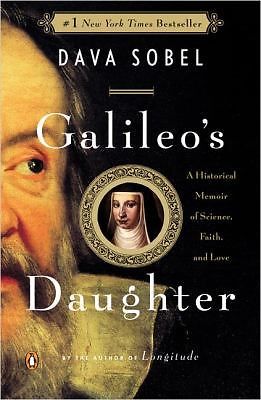Galileo’s Daughter:
A Historical Memoir of Science, Faith and Love
by Dava Sobel
–Review by Teri Hyrkas
How does a writer transform a rigorously researched historical memoir of Galileo Galilei into a touching and fascinating family story? Author Dava Sobel accomplished this bit of magic by discovering a passageway into the life of Galileo that had not been considered before: Galileo’s deep and tender relationship with his oldest daughter, Virginia. Sobel’s book center’s around this affectionate alliance, which was not built on evenings spent entertaining illustrious friends or by long walks together in a garden but from letters exchanged between Galileo and his illegitimate daughter.
Galileo Galilei, (1564-1642),17th century scholar from Florence, Italy, is universally known and respected. History records his world changing accomplishments in the fields of mathematics, observational astronomy, physics, science, engineering and philosophy; this was Galileo’s much honored public life. In his private life, even though he was an observant and faithful Catholic, Galileo fathered three illegitimate children. Sobel tells us that, “Galileo recognized his illegitimate children as heirs of his lineage, and their mother as his mate, although he ever avoided marrying Marina [Gamba]. Scholars by tradition tended to stay single….”
The out-of-wedlock births of his daughters left them unmarriageable. A religious vocation was the only genuine option available to them as they approached adulthood. It is difficult to imagine Galileo’s daughters being amenable to the idea, but Sobel writes, “Virginia adopted the name Maria Celeste when she became a nun, in a gesture that acknowledged her father’s fascination with the stars. Even after she professed a life of prayer and penance, she remained devoted to Galileo as though to a patron saint.”
Sobel’s masterful biography describes the many triumphs and struggles that filled Galileo’s long life, including his well known dispute with the Catholic Church over heliocentrism, the astronomical model in which the Earth and the planets revolve around the Sun at the center of the solar system. Galileo’s support of heliocentrism put him at odds with the prevailing thought of many scientists of that time, as well as with the teaching of the Church; a dilemma that did not see its final resolution until 1992.
Galileo was a true celebrity in his day, a larger than life figure who had numerous admirers as well as his share of enemies, according to Sobel. In Galileo’s Daughter, Sobel strikes a balance between the worldly exploits of Galileo and the unsophisticated, quiet life of his cloistered daughter by juxtaposing Galileo’s feats with letters from Suor Maria Celeste. Suor Maria Celeste was joined at the convent by her younger sister, Livia, who took the name Sister Arcangela. They served their father and community at the San Matteo Convent, close to her father’s residence.
“Most Illustrious and Beloved Lord Father, “As for the citron which you commanded me, Sire, to make into candy, I have come up with only just a little bit that I send you now, because I am afraid the fruit was not fresh enough for the confection to reach the state of perfection I would have liked, and indeed it did not turn out very well after all. Along with this I am sending you two baked pears for these festive days. But to present you with an even more special gift, I enclose a rose, which, as an extraordinary thing in this cold season, must be warmly welcomed by you…. “And ending here, I give you loving greetings, together with Suor Arcangela, and remind you, Sire, that both of us are all eagerness to hear the current state of your health.”
San Matteo, the 19th day of December 1625. Most affectionate daughter, S.M. Celeste
“I am returning the table cloths in which you wrapped the lamb you sent; and you, Sire, have a pillow case of ours which we put over the shirts in the basket with the lid.”
Throughout Galileo’s Daughter these candid, loving letters offer an insider’s view of the Galilei family’s close relationship as well as providing a glimpse into the organization of a convent in the 17th century. They also serve to help the reader see Galileo as a caring albeit faulty father rather than only as a formidable icon of science and religion.
Among the intriguing elements contained in Sobel’s book is a surprise ending. No spoilers here, but you may want to have some tissues close by as you read the final chapter.
The award winning Dava Sobel also has many other books about notable people in the field of science. Her most recent publication is The Glass Universe: How the Ladies of the Harvard Observatory Took the Measure of the Stars (Viking, 2016).

